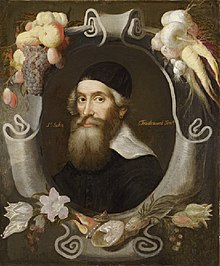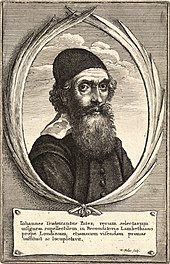John Tradescant the Elder
John Tradescant | |
|---|---|
 John Tradescant the Elder (portrait attributed toCornelis de Neve | |
| Born | 1570s Suffolk |
| Died | 15–16 April 1638 |
| Nationality | English |
| Occupation(s) | Naturalist, gardener, collector and traveller |
John Tradescantthe Elder (/trəˈdɛskənt/;c. 1570s – 15–16 April 1638), father ofJohn Tradescant the Younger,was an English naturalist, gardener, collector and traveller. On 18 June 1607 he married Elizabeth Day ofMeophamin Kent, England. She had been baptised on 22 August 1586 and was the daughter of Jeames Day, also of Meopham.
Life[edit]
John Tradescant was probably born in Suffolk. He began his career as head gardener toRobert Cecil, 1st Earl of SalisburyatHatfield House,who initiated Tradescant in travelling by sending him to theLow Countriesfor fruit trees in 1610/11. He was kept on by Robert's sonWilliam,to produce gardens at the family's London house,Salisbury House.[1] He then designed gardens on the site ofSt Augustine's AbbeyforEdward Lord Wottonin 1615–1623.[1]
In 1623, Tradescant became gardener to the royal favouriteGeorge Villiers, 1st Duke of Buckingham,remodelling his gardens atNew Hall, Essexand atBurley-on-the-Hill.[1] He travelled to theNikolo-Korelsky Monasteryin ArcticRussiain 1618 (his own account of the expedition survives in his collection), to theLevantand toAlgiersduring an expedition against theBarbary piratesin 1620, returned to the Low Countries on Buckingham's behalf in 1624, and finally went toParisand (as an engineer for the ill-fated siege ofLa Rochelle) theÎle de Réwith Buckingham. After Buckingham's assassination in 1628, he was engaged in 1630 byKing Charles Ito be Keeper of his Majesty's Gardens, Vines, and Silkworms at his queen's minor palace,Oatlands Palacein Surrey.

On all his trips he collected seeds and bulbs, from which he assembled a collection of curiosities of natural history and ethnography which he housed in a large house, "The Ark", inLambeth,London.[1] The Ark was the prototypical "Cabinet of Curiosity",a collection of rare and strange objects, that became the firstmuseumopen to the public in England, theMusaeum Tradescantianum. He gathered specimens through American colonists, including his personal friendJohn Smith,who bequeathed Tradescant a quarter of his library. From theirbotanical gardenin Lambeth, on the south bank of theThames,he and his son,John Tradescant the younger,introduced many plants into English gardens that have become part of the modern gardener's repertory.
He is buried in the churchyard of St-Mary-at-Lambeth, as is his son.[2]The churchyard is now established as theGarden Museum.[3]
Legacy[edit]
The Tradescant collection, which was added to significantly by Tradescant's son,John Tradescant the Younger,was later given to theUniversity of OxfordbyElias Ashmole.It was combined with an older University collection to become theAshmolean Museum,which opened in 1683.[1][4][5]
A genus of flowering plants (Tradescantia) was named in honour of the two men byCarl Linnaeusin 1752.[6]
Tradescant Road, off South Lambeth Road inVauxhall,marks the former boundary of the Tradescant estate.[1]
Popular culture[edit]
Tradescant is the subject of the novelEarthly JoysbyPhilippa Gregory.[citation needed]
See also[edit]
- Edward Lhuyd– curator of theAshmolean Museum
References[edit]
- ^abcdef"Tradescant family".The Vauxhall Society. 28 January 2012.Retrieved17 February2023.
- ^Potter 2006.
- ^"The Museum".Garden Museum.Retrieved17 February2023.
- ^"Ashmolean Museum Website – The History of the Ashmolean".Retrieved7 January2019.
- ^"Ashmole dot com website – Biography of Elias Ashmole".Retrieved7 January2019.
- ^Quattrocchi, Umberto (2000).CRC World Dictionary of Plant Names: Common Names, Scientific Names, Eponyms, Synonyms, and Etymology.Vol. IV R-Z. Taylor & Francis. p. 2697.ISBN978-0-8493-2678-3.
Sources[edit]
- Leith-Ross, Prudence (1984).The John Tradescants: Gardeners to the Rose and Lily Queen.P. Owen.ISBN0-720-60612-8.
- MacGregor, Arthur, ed. (1983).Tradescant's Rarities: Essays on the Foundation of the Ashmolean Museum.Clarendon Press.ISBN0-198-13405-3.
- Allan, Mea(1964).The Tradescants. Their Plants, Gardens and Museum 1570–1662.London.
{{cite book}}:CS1 maint: location missing publisher (link) - Potter, Jennifer (2006).Strange Blooms: The Curious Lives and Adventures of the John Tradescants.Atlantic.ISBN1-843-54334-6.
External links[edit]
![]() Media related toJohn Tradescant the Elderat Wikimedia Commons
Media related toJohn Tradescant the Elderat Wikimedia Commons
- 1570s births
- 1638 deaths
- 17th-century English botanists
- 16th-century English botanists
- English gardeners
- People educated at The King's School, Canterbury
- People from Kent
- History of museums
- History of the London Borough of Lambeth
- People from Hertfordshire
- 16th-century gardeners
- 17th-century gardeners
- 17th-century English naturalists
- People associated with the Ashmolean Museum
- 16th-century English naturalists
- Burials at St Mary-at-Lambeth
